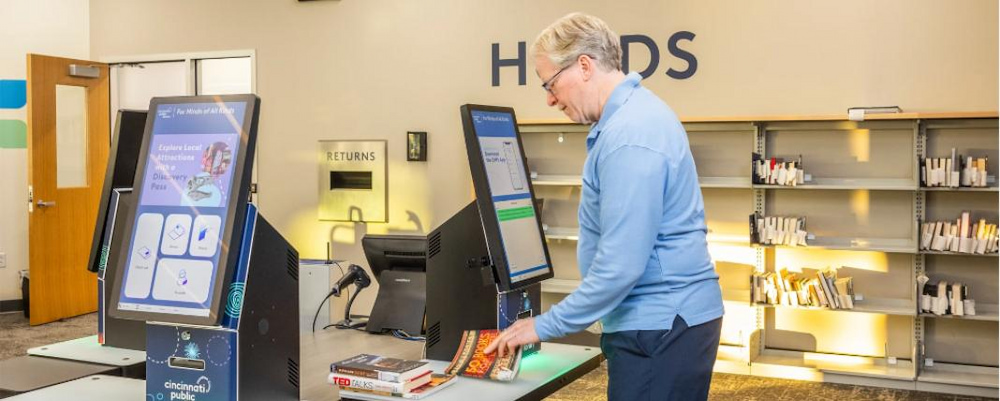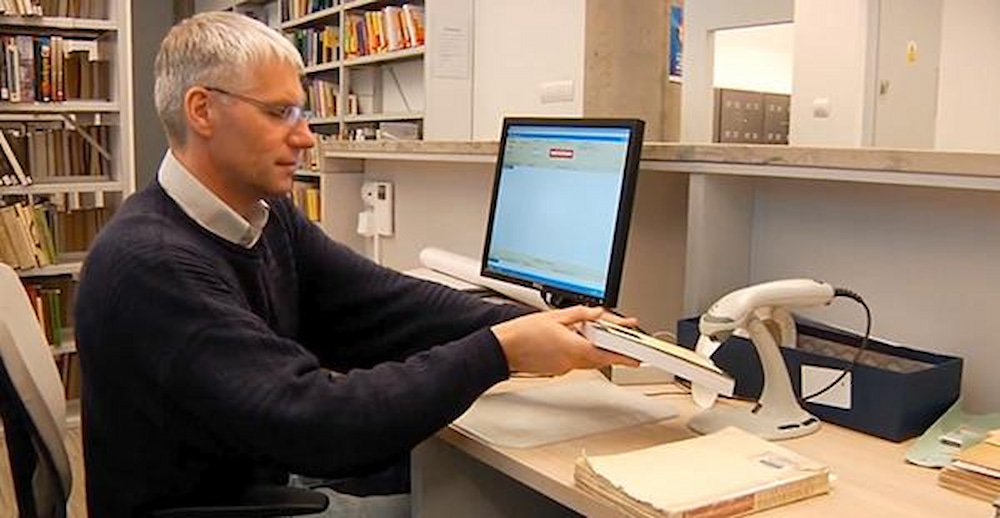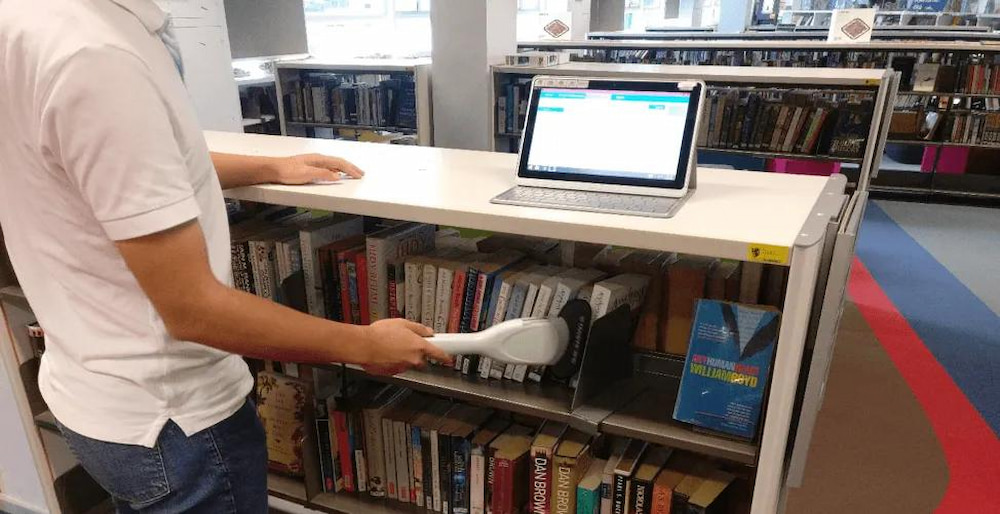La tecnología RFID está reemplazando la identificación tradicional mediante códigos de barras, lo que permite un acceso a las bibliotecas más rápido, seguro e interactivo. Este artículo profundiza en esta tecnología de vanguardia y explora cómo crea una experiencia de préstamo fluida y cómoda, desde el inicio hasta la devolución.
Las bibliotecas utilizan principalmente RFID de alta frecuencia (HF) de 13,56 MHz. Su corto alcance de lectura (normalmente no superior a 1 metro) lo hace ideal para estaciones de préstamo seguras y controladas. Además, permite la lectura simultánea, rápida y precisa de varios artículos.
Una experiencia de préstamo sin complicaciones: una guía paso a paso
Préstamo rápido en 10 segundos
Gracias a la tecnología RFID, los lectores solo tienen que colocar una pila de libros en la máquina de préstamo de autoservicio. lector RFID Identifica todos los artículos con un solo escaneo. Desde la colocación de los libros hasta la recepción del recibo, todo el proceso suele tardar menos de 10 segundos. En comparación con el préstamo manual, este método eficiente puede reducir los tiempos de espera hasta en un 95 %.
Buzones de devolución de libros disponibles las 24 horas, los 7 días de la semana.
Las cajas de devolución de libros equipadas con tecnología RFID revolucionan la experiencia de préstamo. Los lectores solo tienen que depositar los libros en la caja para devolverlos en cualquier momento. El sistema escanea automáticamente cada libro, actualiza la información de la cuenta del lector en tiempo real e incluso puede clasificar los libros en carros para su posterior colocación en las estanterías.
Seguridad instantánea
Las etiquetas RFID que se utilizan para identificar los libros también funcionan como medida de seguridad. Si un libro se ha prestado correctamente, el sistema desactiva automáticamente la etiqueta. Si alguien intenta llevarse un libro no devuelto, la etiqueta en la salida de la biblioteca activará inmediatamente una alarma.

Héroe anónimo: Mejora de la eficiencia operativa de la biblioteca
Gestión rápida de inventario
Gracias a los lectores RFID portátiles, el personal puede moverse fácilmente entre las estanterías. El lector recopila datos de todos los artículos etiquetados dentro de su alcance, escaneando cientos de artículos por minuto.
¡Dile adiós a los libros extraviados!
El personal puede usar escáneres portátiles para la «búsqueda en estantería». El dispositivo compara la ubicación de los artículos con un mapa digital de la estantería y activa una alarma si un artículo está fuera de lugar. Esto facilita considerablemente la búsqueda de artículos en la colección, garantizando que los lectores puedan encontrar los libros disponibles que aparecen en el catálogo.
Abordar las preocupaciones sobre privacidad y seguridad
¿La colección de la biblioteca hará un seguimiento de mis movimientos?
Moderno Etiquetas RFID de biblioteca Por lo general, solo contienen un identificador único, como un número de serie. Este número no tiene significado fuera de la base de datos segura de la biblioteca. Los libros que tomas prestados no se pueden usar para rastrear tus movimientos después de que salgas de la biblioteca.
Estándares de la industria y "Interruptores de desactivación"
Para proteger aún más la privacidad, muchos sistemas tienen un "modo de privacidad" incorporado. La etiqueta se desactiva temporalmente al tomar prestado el artículo hasta que se devuelve.
Pioneros del mundo real: Historias de éxito de la RFID
La Biblioteca Nacional de Singapur
Esta institución ha implementado un sistema de almacenamiento y recuperación totalmente automatizado mediante tecnología RFID. Los lectores reservan libros en línea y un sistema robótico recupera los libros solicitados de un sistema de almacenamiento de alta densidad en cuestión de minutos.

El futuro ya está aquí: Aplicaciones RFID de próxima generación
Estanterías inteligentes y análisis en tiempo real
Las estanterías inteligentes permiten una gestión de inventario continua y pasiva. Pueden rastrear con precisión los libros en los estantes, identificar libros perdidos e incluso alertar inmediatamente al personal si algún libro se encuentra fuera de lugar.
Integración con el Internet de las Cosas (IoT)
Imagina un libro que pueda avisar al sistema de control de temperatura y humedad de la biblioteca cuando la humedad sea demasiado alta, protegiendo así valiosas colecciones. Otra alternativa es que la tecnología de balizas RFID guíe a los lectores con discapacidad visual hasta estanterías específicas. Esta tecnología tiene un enorme potencial para crear entornos interactivos y adaptables.
Mejorar la experiencia del usuario a través de aplicaciones móviles
Las futuras aplicaciones de bibliotecas utilizarán la funcionalidad NFC de los teléfonos móviles para interactuar con los libros. Los lectores podrán simplemente acercar sus teléfonos al lomo del libro para ver las valoraciones, los resúmenes de lectura e incluso tomar prestados libros directamente, fusionando a la perfección los mundos físico y digital.
Cómo tomar una decisión: ¿Es la tecnología RFID adecuada para su biblioteca?
Para los administradores de bibliotecas, invertir en RFID es una decisión estratégica. Considere los siguientes factores:
Volumen de préstamos: Las bibliotecas con un alto volumen de préstamos son las que más se benefician de las mejoras en la eficiencia.
Personal: Si lo que buscas es que tu personal pase de tareas repetitivas a servicios profesionales, la tecnología RFID será un factor clave.
Presupuesto: Si bien la inversión inicial es mayor, el retorno de la inversión a largo plazo de la tecnología RFID en cuanto al ahorro de costos laborales y la prevención de la pérdida de libros está bien documentado.
Orientado al futuro: La RFID es la tecnología fundamental para las bibliotecas inteligentes y conectadas del futuro.
Conclusión: Más que simples etiquetas
La tecnología RFID transforma la biblioteca, convirtiéndola de un simple depósito de información en un espacio comunitario inteligente, eficiente y centrado en el usuario. Gracias a ella, tareas tediosas como el préstamo y la devolución de libros se vuelven prácticamente imperceptibles, permitiendo que la verdadera esencia de la biblioteca —el descubrimiento, el aprendizaje y el intercambio— se desarrolle plenamente.

Chatea ahora
Escanear a WeChat :

Escanear a WhatsApp :
